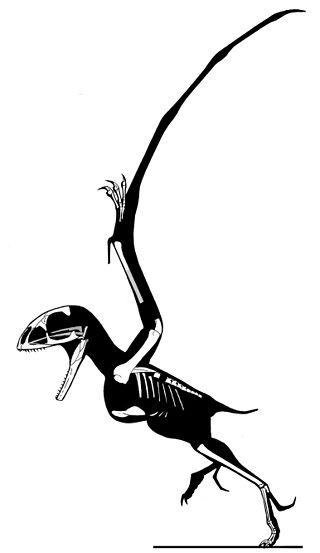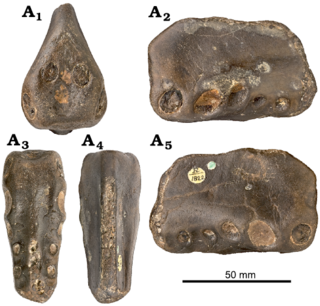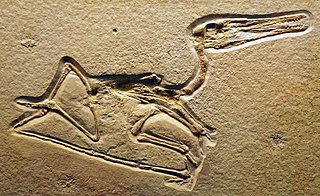Related Research Articles

Ornithocheirus is a pterosaur genus known from fragmentary fossil remains uncovered from sediments in the United Kingdom and possibly Morocco.

Batrachognathus is an extinct genus of anurognathid pterosaur from the Late Jurassic Karabastau Formation of the central Asian republic of Kazakhstan. The genus was named in 1948 by the Russian paleontologist Anatoly Nicolaevich Ryabinin. The type species is Batrachognathus volans. The genus name is derived from Greek batrakhos, "frog" and gnathos, "jaw", in reference to the short wide head. The specific epithet means "flying" in Latin.

Eosipterus is an extinct genus of ctenochasmatid pterosaur from the Early Cretaceous period of Liaoning, China. Fossil remains of Eosipterus dated back to the Aptian stage of the Early Cretaceous, 125 million years ago.

Beipiaopterus is a genus of ctenochasmatid pterosaur from the Early Cretaceous period of what is now the Yixian Formation of the China.

Coloborhynchus is a genus of pterodactyloid pterosaur belonging to the family Anhangueridae, though it has also been recovered as a member of the Ornithocheiridae in some studies. Coloborhynchus is known from the Lower Cretaceous of England, and depending on which species are included, possibly the Albian and Cenomanian ages as well. Coloborhynchus was once thought to be the largest known toothed pterosaur, however, a specimen of the closely related Tropeognathus is now thought to have had a larger wingspan.

Dendrorhynchoides was a genus of anurognathid pterosaur containing only the holotype species D. curvidentatus that is known from the Middle Jurassic Tiaojishan Formation of Qinglong, northern Hebei Province, China.

Diopecephalus is a genus of pterodactyloid pterosaur from the Lower Tithonian of the Lithographic Limestone, Bavaria, Germany. The type and only species is D. kochi, although the name has been applied to Pterodactylus longicollum, with longicollum erroneously listed as the type species.

Nurhachius is a genus of istiodactylid pterodactyloid pterosaur from the Barremian to Aptian-age Lower Cretaceous Jiufotang Formation of Chaoyang, Liaoning, China. Its fossil remains date back about 120 million years ago.
Paleontology or palaeontology is the study of prehistoric life forms on Earth through the examination of plant and animal fossils. This includes the study of body fossils, tracks (ichnites), burrows, cast-off parts, fossilised feces (coprolites), palynomorphs and chemical residues. Because humans have encountered fossils for millennia, paleontology has a long history both before and after becoming formalized as a science. This article records significant discoveries and events related to paleontology that occurred or were published in the year 2002.
Paleontology or palaeontology is the study of prehistoric life forms on Earth through the examination of plant and animal fossils. This includes the study of body fossils, tracks (ichnites), burrows, cast-off parts, fossilised feces (coprolites), palynomorphs and chemical residues. Because humans have encountered fossils for millennia, paleontology has a long history both before and after becoming formalized as a science. This article records significant discoveries and events related to paleontology that occurred or were published in the year 2005.

The Tiaojishan Formation is a geological formation in Hebei and Liaoning, People's Republic of China, dating to the middle-late Jurassic period. It is known for its exceptionally preserved fossils, including those of plants, insects and vertebrates. It is made up mainly of pyroclastic rock interspersed with basic volcanic and sedimentary rocks. Previously, the Tiaojishan Formation was grouped together with the underlying Haifanggou Formation as a single "Lanqi Formation." The Tiaojishan Formation forms a key part of the Yanliao Biota assemblage, alongside the Haifanggou Formation.

Carniadactylus is a genus of pterosaur which existed in Europe during the Late Triassic period. The genus contains a single species, Carniadactylus rosenfeldi.

Opecoelidae is a family of trematodes. It is the largest digenean family with over 90 genera and nearly 900 species, almost solely found in marine and freshwater teleost fishes. It was considered by Bray et al. to belong in the superfamily Opecoeloidea Ozaki, 1925 or the Brachycladioidea Odhner, 1905.
The Eugregarinorida are the most large and diverse order of gregarines — parasitic protists belonging to the phylum Apicomplexa. Eugregarines are found in marine, freshwater and terrestrial habitats. These species possess large trophozoites that are significantly different in morphology and behavior from the sporozoites. This taxon contains most of the known gregarine species.
Caulleryella is a genus of parasitic alveolates of the phylum Apicomplexa. Species in this genus infect insects (Diptera).
Allantocystis is a genus in the family Allantocystidae. Its only species is Allantocystis dasyhelei, a gregarine parasite of the larval biting midge Dasyhelea obscura.
Lipotropha is a genus of parasitic alveolates of the phylum Apicomplexa.

Ornithocheiromorpha is a group of pterosaurs within the suborder Pterodactyloidea. Fossil remains of this group date back from the Early to Late Cretaceous periods, around 140 to 92.5 million years ago. Ornithocheiromorphs were discovered worldwide except Antarctica, though most genera were recovered in Europe, Asia and South America. They were the most diverse and successful pterosaurs during the Early Cretaceous, but throughout the Late Cretaceous they were replaced by better adapted and more advanced pterosaur species such the pteranodontids and azhdarchoids. The Ornithocheiromorpha was defined in 2014 by Andres and colleagues, and they made Ornithocheiromorpha the most inclusive clade containing Ornithocheirus, but not Pteranodon.

Cystidicolidae is a family of spirurian nematodes. It was created by Skrjabin in 1946. All members of the family are parasites of fish.
References
- 1 2 Keilin, D. (1920). "On two new gregarines, Allantocystis dasyhelei n. g., n. sp., and Dendrorhynchus systeni n. g., n. sp, parasitic in the alimentary canal of the dipterous larvae, Dasyhelea obscura Winn. and Systenus sp". Parasitology. 12 (2): 154–158. doi:10.1017/s0031182000014104.
- ↑ Nazeer Ahamed, S.; C. C. Narasimhamurti (1979). "Two new septate gregarines, Dendrorhynchus keilini sp. n. and Ancyrophora ceriagrioni sp. n. from the midgut of the damsel fly, Ceriagrion coromandelianum (Fabr.)". Acta Protozoologica. 18 (3): 441–450.
- ↑ Clopton, R. E. (2002). Phylum Apicomplexa Levine, 1970: Order Eugregarinorida Léger, 1900. Pages 205-288. in: Illustrated Guide to the Protozoa, 2nd edition, J. J. Lee, G. Leedale, D. Patterson, and P. C. Bradbury, eds. Society of Protozoologists, Lawrence, Kansas
- ↑ Annales de parasitologie humaine et comparée. Encyclopédie des sciences médico-biologiques. Section--Parasitologie (in French). Masson. 1965. p. 709. Retrieved 24 June 2019.
David Keilin, éminent biochimiste, membre de la Royal Society, qui découvrit en ... des Grégarines (Dendrorhynchus, Caulleryella, Allantocystis, Schizocystis, Lipotropha) ou des Ciliés (Lambornella).
- ↑ Kajihara, H.; A. V. Chernyshev; S.-C. Sun; P. Sundberg; F. B. Crandall (2008). "Checklist of nemertean genera and species published between 1995 and 2007". Species Diversity. 13 (4): 245–274. doi: 10.12782/specdiv.13.245 .
- ↑ Ji, S.-A.; Q. Ji; K. Padian (1999). "Biostratigraphy of new pterosaurs from China". Nature. 398 (6728): 573–574. doi: 10.1038/19221 .